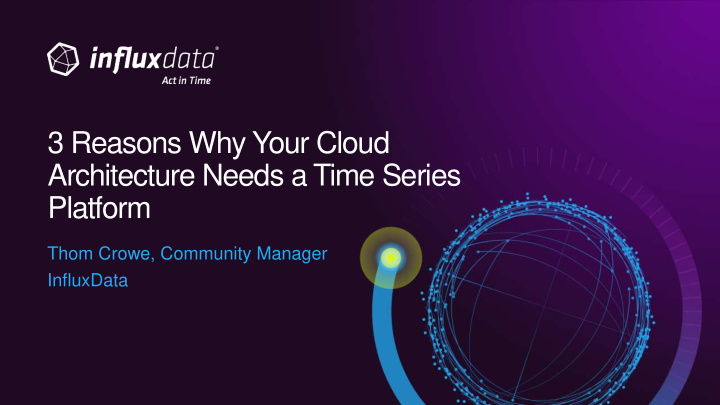



3 Reasons Why Your Cloud Architecture Needs a Time Series Platform Thom Crowe, Community Manager InfluxData
As you adopt: You’re going to DevOps need better Docker monitoring Kubernetes
What You Will Need To Monitor • DevOps Toolchain(s) • Containerized Applications • Containers • Kubernetes Clusters (nodes, pods, etc)
Kubernetes Adoption is Growing
UPTIME: High uptime requires sub-second visibility into architecture Why Care About COMPLEXITY: Ecosystems of microservices Better requires cross-domain visibility Monitoring SCALE: Legacy systems can’t handle the volume of metrics generated
Emergence of Time-Series Platforms for Advanced Monitoring
New Workloads of Metrics and Events Explosion of Connected Things Instrumentation of the Virtual World Consolidating of Metrics/Events Data
What makes o All time-stamped data Events and o Generated in regular and irregular periods Metrics o Huge volumes of data Unique?
o What makes a Ingestion of large volumes of metrics o Real-time queries of large data sets Time Series o Rapid eviction and transformation of data platform o Down sampling of high precision data different? o Storage optimization and compression
The New Architectural Approach SQL Search Big Data Time Series Orders and Logs and Volume and Metrics and Order Lines web pages variety Events
What is InfluxDB?
Platform Strategy: Be The Platform of Choice for All Metrics and Event Workloads [ Common IoT Metrics Monitoring Metrics and Events Platform Analytics Infrastructure Metrics Tracing Business Metrics Machine Learning
InfluxDB’s TICK Stack
Telegraf: Agent for Collecting and Reporting Metrics and Events • Telegraf is plugin-driven and has the concept of 4 distinct plugin types to collect and report metrics: • Input plugins collect metrics from the system, services, or 3rd party APIs • Processor plugins transform, decorate, and/or filter metrics • Aggregator plugins create aggregate metrics (e.g. mean, min, max, quantiles, etc.) • Output plugins write metrics to various destinations • Over 200 plugins, more added every few weeks
InfluxDB: The Modern Time Series Database • Time-series database built from the ground up to handle high write & query loads • Custom high performance data store written specifically for timestamped data, (DevOps monitoring, application metrics, IoT sensor data, & real-time analytics) • Conserve space on your machine by configuring – to keep data for a defined length of time – automatically expiring – deleting any unwanted data from the system • Offers a SQL-like query language for interacting with data
Kapacitor: Real-time Streaming Data Processing Engine • Native data processing engine • Processes both stream and batch data from InfluxDB • Plug in custom logic or user defined functions to – process alerts with dynamic thresholds – match metrics for patterns – compute statistical anomalies – perform specific actions based on these alerts like dynamic load rebalancing • Integrates with Slack, HipChat, OpsGenie, Alerta, Sensu, PagerDuty, and more
Chronograf • Configuration • Dashboards • Visualization • Data Explorer • Templates & Libraries • Alerting & Automation
InfluxDB can monitor Kubernetes, Docker and the Apps Benefits Deploy Telegraf as a Daemonset • for the node and a sidecar for pods Get consistent metrics out of • Telegraf for the nodes and the pods ▪ Implement push style metrics for the whole cluster Use InfluxDB to monitor the K8s cluster (master, nodes, and pods) to gain: • Consistency in metrics • Long-term storage and HA Telegraf is deployed as a DaemonSet on the node • Enable push-style metrics and as a sidecar on the pod(s)
InfluxDB can co-exist in a Prometheus Ecosystem BENEFITS ▪ Build on your investment in Prometheus ▪ Telegraf scrapes Prometheus endpoints ▪ Get full functionality of Telegraf ▪ Use Prometheus style metrics when required Complement your Prometheus investment with InfluxDB to gain - Long Term storage and HA Add ‘push’ style metrics to Prometheus’s ‘pull’ style -
I have Prometheus, why do I need InfluxDB? Security Metrics Clustering, & (Pull) & High Alerting & Availability Events (HA) Preserve (Push) Investment Monitor in both Prometheus K8S and non-K8s
Active Full Stack Monitoring with InfluxDB Driving K8s with InfluxDB In a nutshell.. Helm Charts • Deploy Telegraf as a DaemonSet to start • monitoring nodes, pods and containers. If you want a single platform for metrics and events in your company, then you’ll • Service Operator need to supplement Prometheus to • Operators simplify deployment and backup of InfluxDB OSS using familiar kubectl commands. deliver. • Hashicorp Terraform module(s) • InfluxDB Enterprise Terraform Module for AWS is InfluxDB works with both K8s and non- available now K8s sources to deliver full stack monitoring . Documentation Landing Page
Thank you https://www.influxdata.com/developers/
Recommend
More recommend